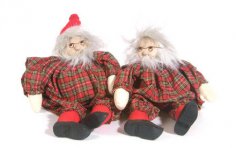
In Scandinavian mythology, nissi (or nisse) are spirits that inhabit houses, barns, and forests. Living in a house, they protect its owners, look after children, help feed pets, and maintain order. In this respect, nissi are very similar to domovoi (house spirits ). While according to Slavic beliefs, domovoi (house spirits) look after the house, banniki (bahnniki) look after the bathhouse, and ovinniki (ovinniki) look after the yard, the Scandinavian nissi is responsible for all aspects of the home and its surroundings. There are also forest, church, and ship nissi, each with their own responsibilities.
The Nissi's appearance exudes good-naturedness and calm. Since the early 20th century, Nissi have been depicted as small men in peasant clothing and wearing red caps. However, in Scandinavian chronicles, Nissi are described as bearded old men the size of a ten-year-old child, capable of becoming invisible. Sometimes they can transform into cats, bulls, and other domestic animals, reminiscent of the Slavic barnyard beasts, who can also assume any form.
Nissi are incredibly hardworking, keeping busy all day and part of the night, with only a few hours of sleep. It's no surprise, then, that nissi dislike laziness. They may even play tricks on people for laziness, hiding their pipes or other belongings, tangling their hair, and tripping them up. Despite their small stature, nissi are strong-willed: if a farmer has provoked the wrath and resentment of a house spirit, they can expect the farm to be destroyed.
Nissi are very fond of animals. A Nissi house-dweller can even reconcile a cat with a dog, or a cat with a mouse. Nissi also dislike gluttony at Christmas, so they may hide their pet pig from their owners to prevent them from eating it during the holidays. Nissi house-dwellers are very attached to their pets and may even leave the house with them. There's a well-known fairy tale about a Nissi who, after his owners sold his beloved horse, left with it, taking all the good luck from the house with him.
Forest nissi are very protective of their neighbors, feeding moose and squirrels, strolling through the thicket with foxes, and enjoying birdwatching. Wild lynxes are to forest nissi what cats are to domestic nissi—you can play with them and scratch them behind the ears.
The weather is always good for the Nissi, although during heavy snowfalls, domestic Nissi have to work harder than usual – they pick up a shovel to help their owners clear the roads, and forest Nissi have to get out their skis hidden in the hollow of a century-old tree – otherwise they won’t be able to get through the forest.
The Christmas Nissi are also known for their love of children and their gifts. They also enjoy themselves, dancing by candlelight and sometimes drinking hot glögg on winter evenings. Nissi are familiar with life's small joys: they enjoy reading fairy tales to their children and grandchildren; when in the forest, they build a small fire and prepare a drink from dried berries. Nissi eat simply—oatmeal—and their true delicacy is sweet rice porridge with cinnamon.
Just as a domovoi has a wife—a domovicha—so too a nissi has a spouse—a busy and caring mistress. Each nissi chooses a life partner very carefully. But once they've made their choice, they win her hand in a very romantic way—for example, by serenading her under her windows. And, of course, nissi families have children—tiny, playful little ones who love to ski—all together—on the same master's ski, play with cats, or hide in kitchen cupboards with dishes.
When moving, the Nissi place their children in a birch bark backpack and carry them to their new home. If a new home is not found, the Nissi may remain with their family in the forest, living in birds' nests or fox holes.
Over time, the Nissi moved from legend to fairy tales, and then onto greeting cards. The most famous biographers of the Nissi were illustrators Jenny Nyström, Kurt Nyström, Harald Wiberg, Erik Forsman, Trygve Davidsen, and Lennart Hellje, who told children and adults about these amazing creatures that have lived alongside humans for centuries.





